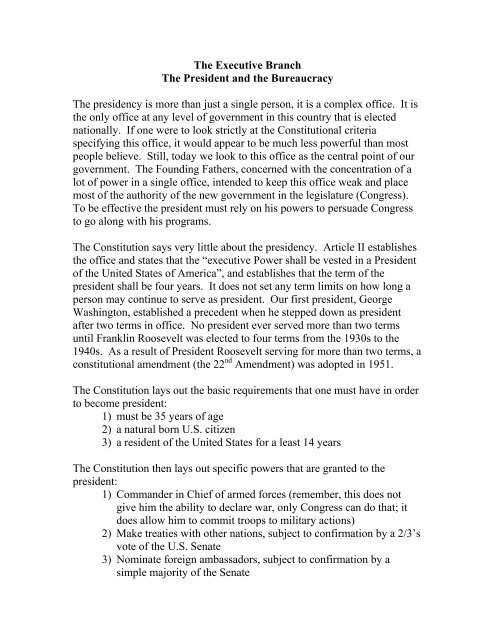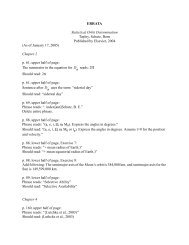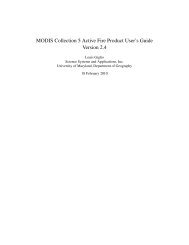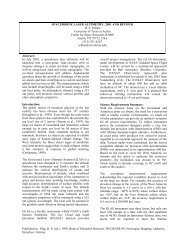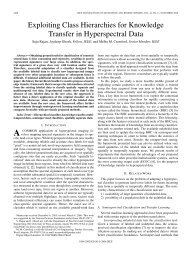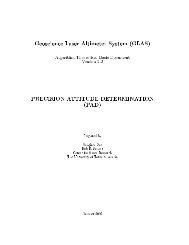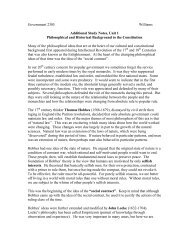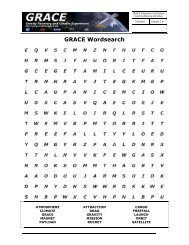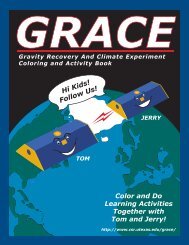Unit 3 Lecture Notes (PDF format)
Unit 3 Lecture Notes (PDF format)
Unit 3 Lecture Notes (PDF format)
- No tags were found...
Create successful ePaper yourself
Turn your PDF publications into a flip-book with our unique Google optimized e-Paper software.
The Executive Branch<br />
The President and the Bureaucracy<br />
The presidency is more than just a single person, it is a complex office. It is<br />
the only office at any level of government in this country that is elected<br />
nationally. If one were to look strictly at the Constitutional criteria<br />
specifying this office, it would appear to be much less powerful than most<br />
people believe. Still, today we look to this office as the central point of our<br />
government. The Founding Fathers, concerned with the concentration of a<br />
lot of power in a single office, intended to keep this office weak and place<br />
most of the authority of the new government in the legislature (Congress).<br />
To be effective the president must rely on his powers to persuade Congress<br />
to go along with his programs.<br />
The Constitution says very little about the presidency. Article II establishes<br />
the office and states that the “executive Power shall be vested in a President<br />
of the <strong>Unit</strong>ed States of America”, and establishes that the term of the<br />
president shall be four years. It does not set any term limits on how long a<br />
person may continue to serve as president. Our first president, George<br />
Washington, established a precedent when he stepped down as president<br />
after two terms in office. No president ever served more than two terms<br />
until Franklin Roosevelt was elected to four terms from the 1930s to the<br />
1940s. As a result of President Roosevelt serving for more than two terms, a<br />
constitutional amendment (the 22 nd Amendment) was adopted in 1951.<br />
The Constitution lays out the basic requirements that one must have in order<br />
to become president:<br />
1) must be 35 years of age<br />
2) a natural born U.S. citizen<br />
3) a resident of the <strong>Unit</strong>ed States for a least 14 years<br />
The Constitution then lays out specific powers that are granted to the<br />
president:<br />
1) Commander in Chief of armed forces (remember, this does not<br />
give him the ability to declare war, only Congress can do that; it<br />
does allow him to commit troops to military actions)<br />
2) Make treaties with other nations, subject to confirmation by a 2/3’s<br />
vote of the U.S. Senate<br />
3) Nominate foreign ambassadors, subject to confirmation by a<br />
simple majority of the Senate
4) Nominate federal judges, subject to confirmation by a simple<br />
majority of the Senate<br />
5) Receive ambassadors of other nations (important because it confers<br />
diplomatic recognition of other governments)<br />
6) May grant pardons for federal crimes (excepts impeachments)<br />
7) Present to Congress “from time to time” in<strong>format</strong>ion on the State<br />
of the Union<br />
8) Convene both Houses of Congress on extraordinary occasions<br />
9) Adjourn Congress if both the House and the Senate cannot agree<br />
on adjournment<br />
10) Nominate officials as provided for by Congress (when new<br />
posts are created because Congress creates a new department or<br />
agency, the president is allowed to name the head of that post)<br />
subject to confirmation by a simple majority of the Senate<br />
11) Fill administrative vacancies during Congressional recesses<br />
12) Recommend legislation to Congress<br />
13) Veto legislation, which could be overridden by a 2/3’s vote of<br />
both Houses of Congress<br />
Compared to the powers given to Congress, the above are much less<br />
substantial. Please notice that a good number of the powers of the president<br />
are contingent upon approval by the Senate. This was indeed deliberate and<br />
part of the concept of separation of powers which we have discussed many<br />
times in class. Government power is to be, theoretically, limited.<br />
Foundations of the Modern Presidency<br />
What has happened over time, however, is that the office of the president has<br />
gained considerable power and authority. Over the course of American<br />
history, the president’s constitutional powers have been extended in practice<br />
beyond the intentions of the Founding Fathers. Though only Congress can<br />
declare war, presidents have made war by sending troops into military<br />
action. Presidents have power over U.S. diplomacy and have surpassed<br />
Congress in functioning as the principle architect of foreign policy, using<br />
executive agreements as a device to bypass the Senate’s formal treaty<br />
making authority. Even the president’s authority to appoint administrators<br />
and the execute laws has exceeded the vision of the Founding Fathers. The<br />
power to execute laws enables presidents to determine how laws will be<br />
interpreted and applied. Presidents possess legislative authority not only to
use the veto but also to recommend proposals to Congress. For all these<br />
reasons, a more activist presidency has evolved during the modern era.<br />
Your textbook discusses reasons why presidential powers have evolved over<br />
time. There are three key theories of presidential power that account for<br />
this, as well as a historical progression of expansion of power at the federal<br />
level:<br />
1) The Whig theory of presidential power holds that the presidency<br />
is a limited or constrained office whose occupant was confined to<br />
the exercise of expressly granted constitutional authority. Most of<br />
the early presidents of this country followed this theory in how<br />
they exercised the power of the presidency.<br />
2) The stewardship theory of presidential power calls for a strong,<br />
assertive presidential role that, in the words of Theodore<br />
Roosevelt, directs the president “to do anything that the needs of<br />
the Nation demanded unless such action was forbidden by the<br />
Constitution or by the laws.” Most presidents since the turn of the<br />
20 th Century have been more of this model than previous<br />
presidents.<br />
3) The prerogative theory of presidential power, which is not<br />
mentioned in the text, carries the role of the president into more<br />
assertive and aggressive areas, often going outside the Constitution<br />
and the nation’s laws. This theory of “paramount necessity” as<br />
defined by Abraham Lincoln and used by Franklin Roosevelt and<br />
Richard Nixon pushes the direction of the presidential exercise of<br />
power into imperial or dictatorial areas, raising legal and ethical<br />
questions regarding its use. Food for thought: Do you consider the<br />
presidency of George W. Bush to be of this type<br />
4) Originally the states were very strong in the new republic and the<br />
<strong>Unit</strong>ed States was not always an international power. Expansion<br />
of the federal government’s policymaking role, the evolution of a<br />
large and active government, and the broader national and<br />
international responsibilities of the <strong>Unit</strong>ed States require strong<br />
leadership from presidents.<br />
5) Because of the president’s constitutional authority as chief<br />
diplomat and military commander plus the special demands of<br />
foreign policy leadership, the president, not Congress, has taken<br />
the lead in addressing the <strong>Unit</strong>ed States’ increased responsibilities<br />
in the world.
6) With increased regulatory and policy responsibilities, public<br />
pressure for leadership in the areas of the economy, education,<br />
environmental protection and other areas, presidential authority has<br />
grown in the domestic areas as well.<br />
The Electoral College<br />
Perhaps no aspect of the presidency is as confusing as how it is that we go<br />
about choosing the president. The president is not chosen by direct popular<br />
election. Instead the Founding Fathers created a system of indirect election<br />
of the president known as the Electoral College. There were several<br />
reasons why the Founding Fathers chose to create this method of choosing<br />
the president, but two are more important than the others. First of all was<br />
the conflict between the states. Each of the states was very suspicious and<br />
jealous of the other states. With population differences there was concern<br />
that a direct election of the president would favor the states that had larger<br />
populations. Second, was a distrust of the will of the people. It was thought<br />
that the people might make an unwise decision depending on who ran for<br />
office. The Founding Fathers thus wanted a way to temper the will of the<br />
people. Originally the electors were to be chosen by the states, most<br />
probably each state’s legislatures, and would act as the most informed of the<br />
citizens of the nation, thus choosing the most qualified leader.<br />
By design each state was provided with the same number of electors as they<br />
had members of Congress (U.S. Representatives and Senators). After the<br />
popular election was held, the electors were to gather in the capital of each<br />
state to cast their ballots (this was to try to preclude bribery and/or<br />
corruption). The electors were not required to vote according to the outcome<br />
of the popular vote, though they could take it into consideration. Once the<br />
ballots of the electors were cast, they were sealed and sent to the U.S. capital<br />
where they were opened when the new Congress convened. A candidate for<br />
president had to receive a majority of the electoral votes cast. If no<br />
candidate received a majority, then the election was settled by the House of<br />
Representatives. This part of the electoral system survives to today.<br />
After the presidency of George Washington, the results of the use of the<br />
Electoral College were mixed. The election of 1800 was the first to provide<br />
controversy. Thomas Jefferson and Aaron Burr both received equal<br />
numbers of electoral votes, and the House was required to settle the election.<br />
It took 36 ballots for the House to finally choose Jefferson as president, and
there were charges of corruption and deals to finally break the deadlock.<br />
The election of 1828 finally brought about some changes in the way the<br />
Electoral College functioned. In 1824 Andrew Jackson overwhelmingly<br />
won the popular vote and received the most electoral votes, but not a<br />
majority. The House of Representatives decided that John Quincy Adams<br />
was a better choice for president than Jackson and chose him, which left<br />
supporters of Jackson quite unhappy. In 1828 Jackson was finally elected<br />
president. At his behest, the states decided to change how electors voted.<br />
Electoral votes were now tied to the popular vote. A new provision called<br />
unit rule was implemented, which required that whichever candidate won the<br />
most votes in the popular vote then they were to be given all of the electoral<br />
votes from that state. Over time even this provision has had problems in that<br />
it is now theoretically possible for one candidate to win the popular vote, yet<br />
another candidate to win the electoral vote (which most recently happened in<br />
the 2000 election between George W. Bush and Al Gore). Though there<br />
has been considerable criticism of this system of choosing the president<br />
there have been no fundamental changes to how it works since Jackson’s<br />
election in 1828.<br />
Removal of the President<br />
The Founding Fathers were aware that under certain extraordinary<br />
circumstances a president might be required to be removed from office.<br />
Thus they created a process to provide for this. It is also the process by<br />
which federal judges can be removed from the bench. In short, it is referred<br />
to impeachment, but it is actually a two step process involving both houses<br />
of Congress. The Constitution states that a president “shall be removed<br />
from Office on Impeachment for, and Conviction of, Treason, Bribery, or<br />
other high Crimes and Misdemeanors.” Exactly what constitutes these<br />
transgressions has been subject of much debate among scholars over the<br />
years. Essentially, it comes down to what Congress believes about a<br />
president and his conduct in office.<br />
The first step in the process of removal of a president from office is<br />
impeachment. This occurs in the House of Representatives. Again, the<br />
Constitution is vague on the exact process, but what has happened<br />
historically is that there have been hearings within the House followed by a<br />
vote. If a simple majority of the members of the House vote for<br />
impeachment, then the process moves to the Senate. At this point the<br />
Constitution states that this step constitutes a trial, and must be presided over
y the Chief Justice of the Supreme Court. At the end of the trial the<br />
members of the Senate vote for or against conviction. If, by a 2/3’s vote of<br />
the members of the Senate, the president is found guilty, then he is removed<br />
from office and is not allowed to ever hold public office again.<br />
No president has ever been removed from office. Two presidents, Andrew<br />
Johnson and William Clinton, both were impeached by the House, but failed<br />
conviction by the Senate (Johnson by a mere one vote), thus avoiding<br />
removal from office. President Richard Nixon, who was under investigation<br />
by the House and the Senate for crimes associated with the Watergate breakin,<br />
was forced to resign the presidency due to the fact that he knew he was<br />
going to be impeached and convicted. Rather than face the humiliating<br />
process he chose resignation instead.<br />
Organization of the Presidency<br />
The president is often called the “chief executive” because he oversees the<br />
executive branch of government. In today’s government this is a huge task.<br />
The modern presidency is a complex office and a very large organization.<br />
We cannot begin to understand the presidency without also having some<br />
type of understanding of the bureaucracy that serves underneath the<br />
president. When we speak of the growth of government, we mostly mean<br />
the growth of the executive branch. Before we start to consider what we<br />
mean by “bureaucracy”, let’s take a look at the organization of the<br />
presidency and the executive branch.<br />
White House staff: most direct and personal services. Includes president’s<br />
Chief of Staff, personal assistants, close personal advisors, press agents,<br />
legislative and group liaison aides, and other special assistants. (totals<br />
around 600 people who work in the White House). Presidents organize the<br />
White House staff the way they want them. Most presidents employ a<br />
hierarchical structure with the chief of staff at the top overseeing the rest of<br />
the staff.<br />
Executive Office of the President. Provides support services to the president<br />
in several policy areas. Three major policymaking bodies are here: National<br />
Security Council (NSC), Council of Economic Advisors (CEA), and Office<br />
of Management and Budget. (several other small units also exist to serve the<br />
president, but these are the main ones in EOP).
National Security Council. A committee that links the president’s key<br />
foreign and military policy advisors together. Formal members include the<br />
president, the vice-president, secretary of state, secretary of defense, and the<br />
president’s national security advisor, who runs the council’s staff. The<br />
advisor and the staff provide the president with in<strong>format</strong>ion and policy<br />
recommendations on national security.<br />
Council of Economic Advisors. Only three members, each appointed by the<br />
president, who advice him on economic policy. Prepare an annual report<br />
(Annual Report of the Council of Economic Advisors) and help the president<br />
make policy on inflation, unemployment, and other economic matters.<br />
Office of Management and Budget. Used to be called Bureau of the Budget.<br />
A few appointees, but mostly career officials (approx. 600). Most important<br />
job is to prepare the president’s budget. Reviews proposals from various<br />
agencies and determines whether they want to let an agency take the<br />
proposal to Congress. Reviews budgets from agencies and puts them into a<br />
single overall budget proposal to go to Congress. Also plays an important<br />
role in reviewing regulations proposed by departments and agencies.<br />
Bureaucracy<br />
What is bureaucracy Simply, it is a method of organizing people and work.<br />
It is based on the principles of hierarchical authority, job specialization, and<br />
formalized rules. As a form of organization, bureaucracy is often seen as the<br />
most efficient means of getting people to work together on tasks of great<br />
magnitude and complexity. Unfortunately, it is also prone to waste,<br />
complex and confusing rules, and rigidity.<br />
Textbook: a major theme you should be aware of is the current initiative to<br />
“re-invent” government.<br />
The U.S. bureaucracy employs more than 2.5 million people who have<br />
responsibility for administering thousands of programs. There are 5 general<br />
types of organizations within the bureaucracy:<br />
1) The Cabinet. There are 14 (now 15) cabinet (executive) departments<br />
headed by a secretary who serves as a member of the president’s cabinet and<br />
is responsible for establishing the department’s general policy and<br />
overseeing its operations. Originally only 4:
State<br />
Treasury<br />
War (now called Defense)<br />
Justice<br />
Others today include:<br />
Energy<br />
Education<br />
Housing and Urban Development<br />
Health and Human Services<br />
Transportation<br />
Labor<br />
Commerce<br />
Agriculture<br />
Interior<br />
Veteran Affairs<br />
-<br />
Homeland Security<br />
All of the heads are appointed by the president, subject to<br />
confirmation by the Senate. All have been created by Congress, but<br />
exist under the executive branch to oversee large policy areas.<br />
2) Independent agencies. These have narrower areas of responsibility than<br />
cabinet departments. Examples include NASA, the CIA, and NOAA.<br />
3) Regulatory agencies. Created when Congress recognizes the importance<br />
of close and continuous regulation of an economic activity. They can issue<br />
regulations, implement them, and judge compliance with them. Examples<br />
include the SEC, EPA, and NRC.<br />
4) Government corporations. These charge clients for their services and are<br />
governed by a board of directors. They receive federal funding to help<br />
defray operating expenses, and their directors are appointed by the president<br />
with Senate approval. Examples include the U.S. Postal Service, and the<br />
FDIC.<br />
5) Presidential commissions. Commissions (some permanent, some<br />
temporary) that provide ongoing recommendations to the presidents in<br />
particular areas of responsibility.
More than 90 percent of federal employees are hired through merit criteria.<br />
Merit hiring protects government workers from being fired for partisan<br />
reasons. Important to remember that federal employees have few rights of<br />
collective action.<br />
The president has substantial appointment powers. All of the heads of these<br />
departments are appointed. The president also appoints directors and top<br />
deputies of federal agencies, members of federal commissions, and heads of<br />
regulatory agencies. In all the president appoints over 5000 positions. This<br />
allows him to have substantial influence over policy of all of these various<br />
departments and agencies.<br />
However, this can also be a weakness. Hard to know 5000 people, and hard<br />
to control them all. Also, as we discuss the bureaucracy, it is important to<br />
remember that the overwhelming majority of them are not appointed but<br />
hired within a merit system, thus they are permanent employees usually<br />
more loyal to the organization than to the president.<br />
The primary function of administrative agencies is policy implementation,<br />
which is to say that they carry out the authoritative decisions of Congress,<br />
the president, and the courts. The bureaucracy does not simply administer<br />
policy; it also makes it and judges it (quasi-powers – mimic the powers of<br />
the three branches of government: quasi-legislative, quasi-executive,<br />
and quasi-judicial.).<br />
1) the bureaucracy initiates ideas for legislative programs.<br />
2) Administrative agencies develop public policy in the process of<br />
implementing it. Through rule making, administrative agencies<br />
decide how the law will operate in practice.<br />
3) Agencies are charged with delivery of services.<br />
4) Agencies determine whether others are complying with policy.<br />
The characteristics that we associate today with bureaucracy were first noted<br />
by a German sociologist named Max Weber. Was doing a study on<br />
authority, and found these common characteristics:
1) hierarchical authority structure. Hierarchy refers to an organizational<br />
arrangement that puts few people with maximum power at the top and<br />
many people with little power at the bottom.<br />
2) Task specialization. Experts instead of amateurs perform technical<br />
jobs. People work on specific tasks rather than several things.<br />
3) Development of extensive rules. These may seem nit-picking at<br />
times, but it allows the organization to handle similar cases in a<br />
similar manner instead of capriciously.<br />
4) Operates on the merit principle. Entrance and promotion are awarded<br />
on the basis of demonstrated abilities rather than on “who you know”.<br />
5) Behave impersonally. Allows all clients to be treated impartially. In<br />
theory, they are politically neutral.<br />
6) Defined jurisdictions. These are created to accomplish definite and<br />
limited goals.<br />
In reality, modern bureaucracies differ greatly from this model. Modern<br />
characteristics include:<br />
1) instead of a single administrator heading an agency they are often<br />
headed by boards and commissions which act to diffuse authority and<br />
accountability.<br />
2) The are often characterized by overlapping jurisdictions. Limits on<br />
goals and authority are obscured, which leads to confusion and<br />
competition among agencies. Often there is also competition over<br />
funding, and agencies can at times be characterized as being<br />
overzealous. Furthermore, despite the overlap, there are often times<br />
when items will fall between the cracks of various agencies.<br />
3) Bureaucracies are not politically neutral. It is very difficult to get<br />
personnel to divorce themselves of feelings towards subjects within<br />
the political process.<br />
4) Rules designed to ensure consistency and fairness sometimes<br />
contradict one another.<br />
5) The role of the “expert” is often unclear. In addition, experts often<br />
disagree with one another, causing confusion over which path to<br />
follow.<br />
6) There is often a reliance on managers to oversee policy<br />
implementation and to act as brokers between citizens and elected<br />
officials. Layers of management often isolate the citizen-customer<br />
from key decision makers, causing great frustration to the citizens<br />
involved in the process.
7) Elected officials, primarily the executive branch, frequently<br />
reorganize agencies in an attempt to make them more accountable to<br />
the legislative process.<br />
Big government came about from a variety of factors. Among these are:<br />
1) The Industrial Revolution. The mechanization of farms and ranches and<br />
the technological revolution led to the urbanization of the nation.<br />
2) The combination of a pseudo-laissez-faire business philosophy and<br />
Social Darwinism eventually produced the conditions that led to an<br />
unpredictable boom-and-bust economy and widespread poverty.<br />
3) Political developments emanating from these economic problems led<br />
eventually to national government intervention in an attempt to curb the<br />
worst excesses of big business and to protect those who were unable to<br />
protect themselves.<br />
The first bureaucratic agency created to protect groups was the Interstate<br />
Commerce Commission (ICC) which was created in 1887 to regulate<br />
railroads, which had been pricing small farmers out of business by charging<br />
exorbitant freight rates.<br />
The scope of government continued to expand after World War II primarily<br />
as the increasing complexity of society also created a need for governmental<br />
expansion. With the demand for new services and rapid population growth<br />
the size and scope of state and local government also increased.<br />
The election of Ronald Reagan in 1980 signaled major political and<br />
ideological changes. The role of states in the American federal system was<br />
increased dramatically. Cuts in federal funding forced reductions in state<br />
and local social programs previously financed by the national government.<br />
Citizens began to question the high cost of governmental services and to<br />
demand more accountability from the administrative state.<br />
Bureaucrats seek first survival and then growth for three basic reasons:<br />
1) To protect their jobs.<br />
2) To promote their organization’s programs.<br />
3) To serve their clientele.<br />
Clientele groups are the groups that are supposed to be regulated by the<br />
bureaucratic agency. Regulation frequently becomes promotion as the<br />
relationship between the two matures.
A civil service system is one in which workers are hired on merit<br />
(performance on written tests or other forms of examinations) and are<br />
evaluated on the basis of their job performance.<br />
Bureaucrats often have considerable administrative discretion. They are<br />
relatively free to use their own judgment as to just how the laws will be<br />
carried out.<br />
Goal displacement is the shifting of bureaucratic orientation, the<br />
replacement of one goal for another. In this case the public interest is<br />
forgotten and the agencies’ interests and those of clientele groups become<br />
paramount.


